Glencoe Math Course 3 Volume 2 Student Chapter 6 Transformations Exercise 6.2
Page 461 Exercise 1, Problem1
We have been given a figure. We need to show or describe the change in position of the figure. This can be found by the phenomena of motion.
Motion is the phenomenon in which an object changes its position over time. Motion is mathematically described in terms of displacement, distance, velocity, acceleration, speed, and time.
The best way to show or describe the change in position of a figure is through its motion.
Page 461 Exercise 1, Problem2
It is said that Art Pysanky is the ancient Ukrainian art of egg decorating. We need to create our own Pysanky design. This can be done by considering the coordinate axes in the coordinate plane as the lines of symmetry.
The pysanky design can be created by drawing a design in quadrant II and drawing its reflections in the other quadrants.
The design is:
The pysanky design is as follows, pysanky design.
Page 461 Exercise 2, Problem1
It is given that Line symmetry is when a figure can be folded so one side is the mirror image of the other side.
We need to find whether the given pysanky have line symmetry.
This can be found by seeing that if after folding the figure vertically or horizontally, the two sides are mirror images of each other.
When the pysanky is folded horizontally, The two sides do not coincide and hence are not mirror images of each other.
Thus, the horizontal line is not a line of symmetry.
When the pysanky is folded vertically, The two sides do not coincide and hence are not mirror images of each other.
Thus, the vertical line is not a line of symmetry.
The given pysanky has zero line symmetry.
Page 463 Exercise 1, Problem1
It is given that a Triangle PQR has vertices P(1,5), Q(3,7), and R(4,-1). We need to find the coordinates of the reflected image. This can be found by finding the coordinates of the vertices of the reflected image.
The triangle with the given coordinates is as follows,
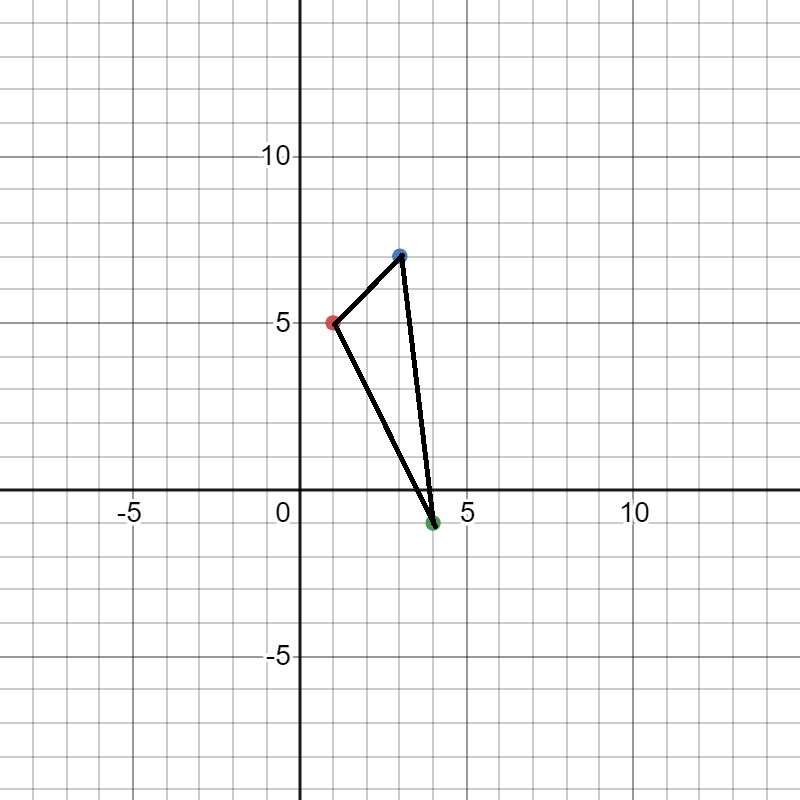
The reflected image is as follows,

The reflected image is as follows,
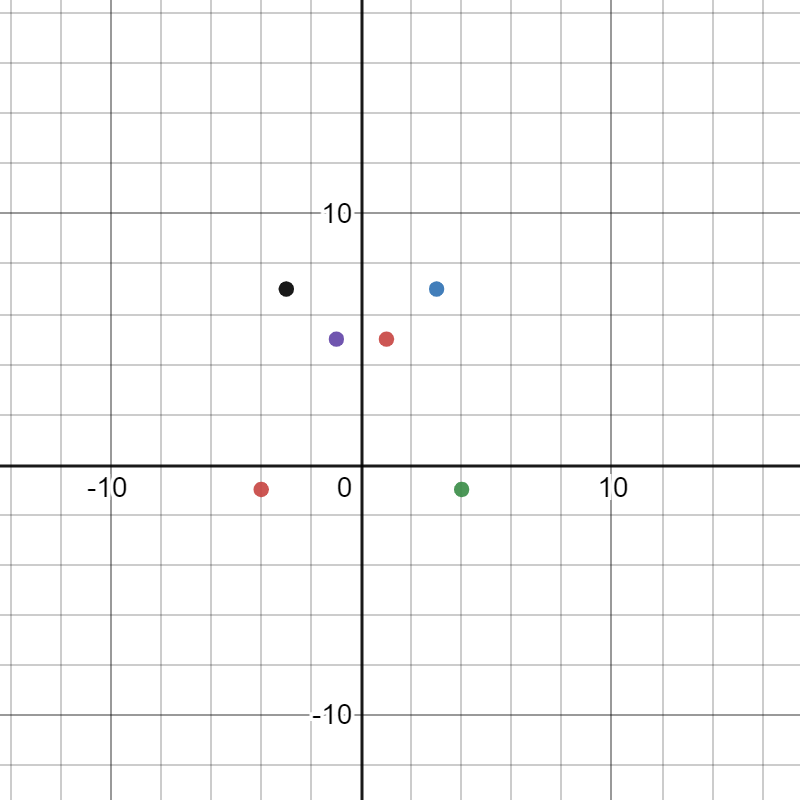
P’=(-1,5)
Q’=(-3,7)
R’=(-4,-1)
The coordinates of the reflected image are as follows,
P’=(-1,5)
Q’=(-3,7)
R’=(-4,-1)
Page 463 Exercise 1, Problem2
A figure is given. We need to reflect the figure over x-axis and find the coordinates of A’ and B’.
This can be found by seeing that when a point is reflected over the x-axis, only it’s y-coordinate changes.
The coordinates of the reflected points as can be found from the graph are as follows,
A′(−2,−2)
B′(2,−2)
The reflected image on the coordinate plane is as follows,
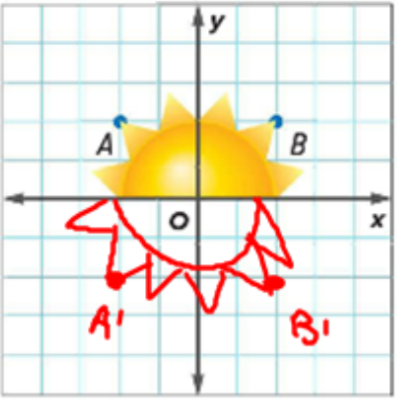
The coordinates of the reflected points are A′(−2,−2),B′(2,−2).
Page 464 Exercise 1, Problem1
It is given that a Triangle ABC has vertices A(5,1), B(1,2), and C(6,2).
We need to find the coordinates of the reflected image.
This can be found by finding the coordinates of the vertices of the reflected image.
The given points are as follows,

The triangle with the given coordinates is as follows,
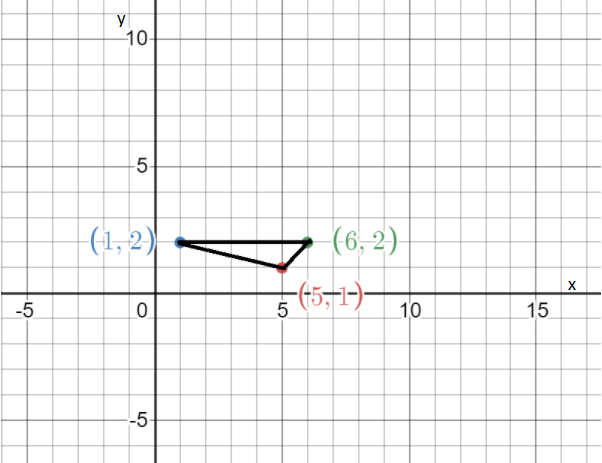
The reflected image is as follows,
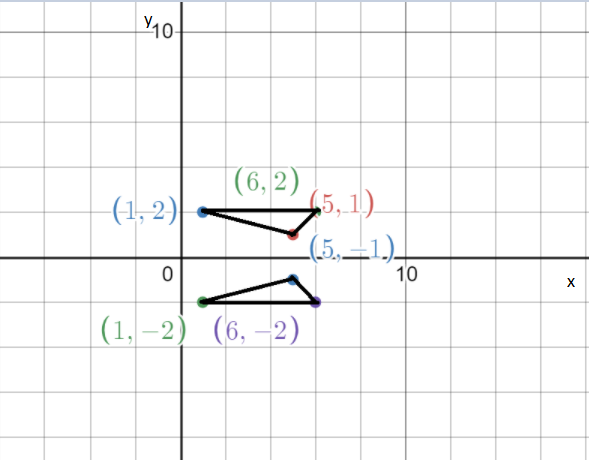
The coordinates of the vertices of the reflected figure is,
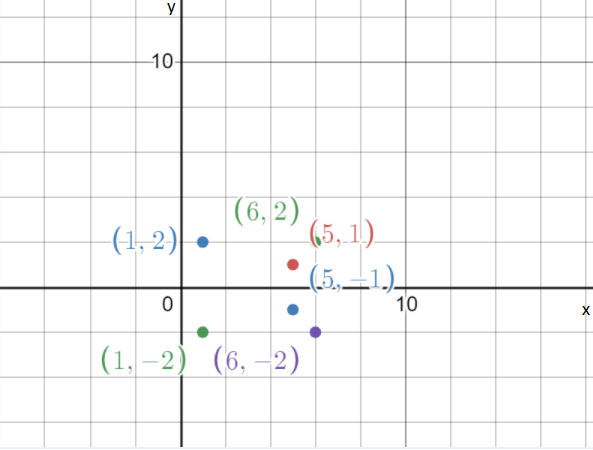
A’=(5,-1)
B’=(1,-2)
C’=(6,-2)
The coordinates of the reflected image are as follows,
A’=(5,-1)
B’=(1,-2)
C’=(6,-2)
Page 464 Exercise 2, Problem1
A figure is given. We need to reflect the figure over y-axis and find the coordinates of A’ and B’.
This can be found by seeing that when a point is reflected over the x-axis, only it’s y-coordinate changes.
The coordinates of the reflected points areA′ (0,−11),B′(10,−10).
Page 464 Exercise 3, Problem1
A figure is given. We need to find the coordinates of the figure after a reflection over either axis.
This can be found by the fact that after reflection over a particular axis, the coordinate of that axis remains the same and the other changes.
If the point is to be reflected over the x-axis, keep the coordinate of x-axis the same and take the opposite of the y-coordinate.
If the point is to be reflected over the y-axis, keep the coordinate of y-axis the same and take the opposite of the x-coordinate.
The coordinates of a figure after a reflection over either axis is determined by keeping the coordinate of that axis constant.
Page 465 Exercise 1, Problem1
It is given that a Triangle GHJ has vertices G(4,2), H(3,-4), and J(1,1).
We need to find the coordinates of the reflected image.
This can be found by finding the coordinates of the vertices of the reflected image.
the given points are as follows
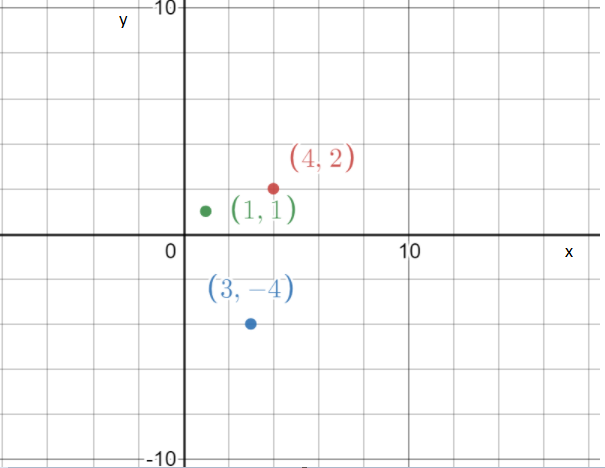
The triangle with the given coordinates is as follows,
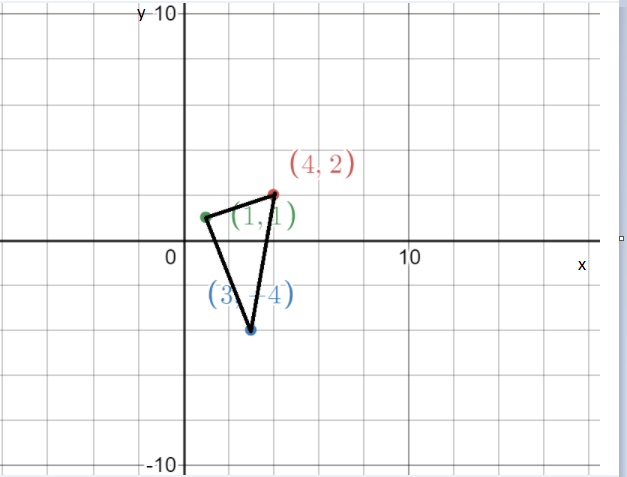
The reflected image is as follows,

The coordinates of the vertices of the reflected figure is,

G’=(-4,2)
H’=(-3,-4)
J’=(-1,1)
The coordinates of the reflected image are as follows,
G’=(-4,2)
H’=(-3,-4)
J’=(-1,1)
Page 465 Exercise 2, Problem1
It is given that a Triangle MNP has vertices M(2,1), N(-3,1), and P(-1,4).
We need to find the coordinates of the reflected image.
This can be found by finding the coordinates of the vertices of the reflected image.
The given points are as follows,
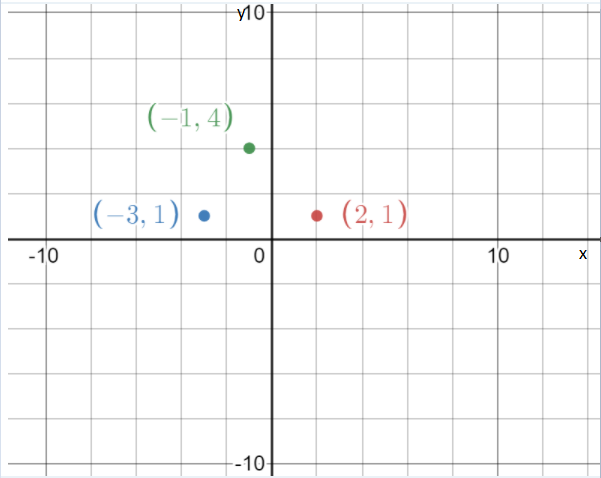
The triangle with the given coordinates is as follows,

The reflected image is as follows,

The coordinates of the vertices of the reflected figure is,
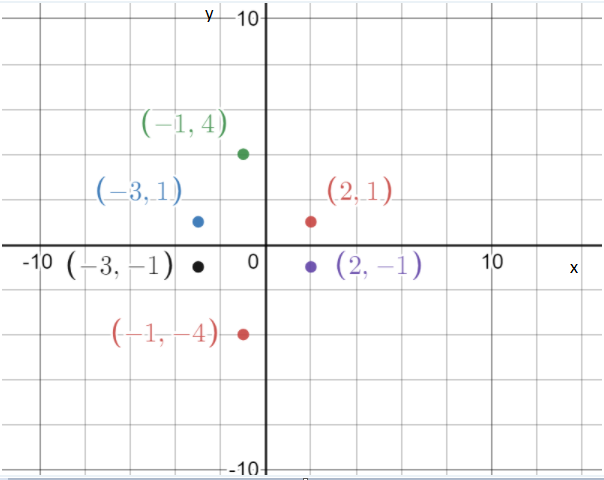
M’=(2,-1)
N’=(-3,-1)
P=(-1,-4)
The coordinates of the reflected image are as follows,
M’=(2,-1)
N’=(-3,-1)
P=(-1,-4)
Page 465 Exercise 3, Problem1
It is given that a quadrilateral WXYZ has vertices W(-1,-1), X(4,1), Y(4,5), and Z(1,7).We need to find the coordinates of the reflected image.
This can be found by finding the coordinates of the vertices of the reflected image.
The given points are as follows,

The quadrilateral with the given coordinates is as follows,
The reflected image is as follows,
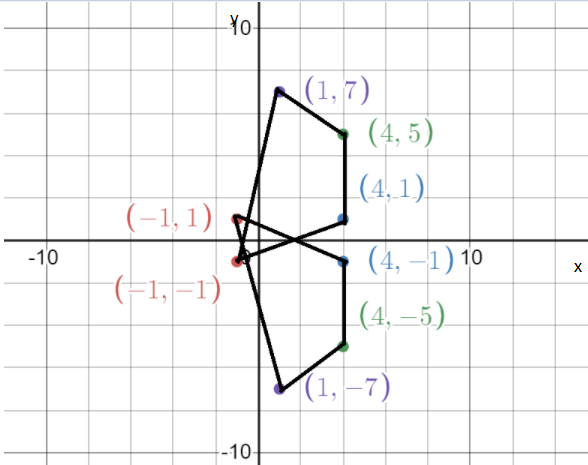
The coordinates of the vertices of the reflected figure is,

W’=(-1,1)
X’=(4,-1)
Y’=(4,-5)
Z’=(1,-7)
The coordinates of the reflected image are as follows,
W’=(-1,1)
X’=(4,-1)
Y’=(4,-5)
Z’=(1,-7)
Page 465 Exercise 4, Problem1
Given vertices of quadrilateral are D(1,0),E(1,−5),F(4,−1),G(3,2).
We have to find the coordinates of the reflected image When we translate quadrilateral over the y-axis, the y- coordinate of each of its vertices remains the same, and the x-coordinate will get multiplied by −1.
Given vertices of a quadrilateral areD(1,0),E(1,−5),F(4,−1),G(3,2).
When we translate quadrilateral over the y-axis, the y- coordinate of each of its vertices remains the same, and the x-coordinate will get multiplied by −1.
Therefore, new coordinates are,D(1,0)=D′(−1,0)E(1,−5)=E′(−1,−5)F(4,−1)=F′(−4,−1)G(3,2)=G′(−3,2)
Therefore, a Graph of given vertices and its reflected image becomes,

The coordinates of a quadrilateral DEFG after a reflection over y-axis are D′(−1,0), E′(−1,−5), F′(−4,−1), G′(−3,2).
Page 465 Exercise 5, Problem1
We have to find the coordinates of the point A′ and point B′.
When the figure is reflected over the x-axis, its x-coordinate remains the same, and the y-coordinate will get multiplied by −1.
When the figure is reflected over the x-axis, its x -coordinate remains the same, and the y -coordinate will get multiplied by−1.
The coordinates of the initial points are A(−3,3), B(3,3) after reflection over x-axis, the new coordinates will be
Sketch of the image on the coordinate plane,

The new coordinates after reflection are A′
(−3,−3),B′
(3,−3)
.
Page 465 Exercise 6, Problem1
Given point is M(3,3) →M′(3,−3).
When the figure is reflected over the x-axis, its x-coordinate remains the same, and the coordinate will get multiplied by −1.
When the figure is reflected over the y-axis, its y-coordinate remains the same, and the x-coordinate will get multiplied by −1.
We have to describe the reflection as over the x-axis or y-axis.
When the figure is reflected over the x-axis, its x-coordinate remains the same, and the y -coordinate will get multiplied by−1.
When the figure is reflected every y-axis, its y-coordinate remains the same, and the x-coordinate will get multiplied by −1.
Given point is M(3,3)→M′(3,−3)
Here we can see that y-coordinate of point M′is negative of the initial point M.
Hence, the point is reflected through x-axis.
When the figure is reflected over x-axis, its x-coordinate remains the same, and the y-coordinate will get multiplied by−1
.
When the figure is reflected over y-axis, its y-coordinate remains the same, and the x-coordinate will get multiplied by −1.
Given point is M(3,3)→M′(3,−3)
Here we can see that y-coordinate of point M′is negative of the initial point M.
Hence, the given pointM(3,3)→M′(3,−3)is reflected throughx-axis.
Page 466 Exercise 7, Problem1
Given coordinates of vertex of triangle are J(−7,4),K(7,1),L(2,−2).
When the point is reflected over x-axis, its x-coordinate remains the same, and the y-coordinate will get multiplied by−1.
When the point is reflected over y-axis, its y-coordinate remains the same, and the x-coordinate will get multiplied by−1.
We know that, when the figure is reflected over x-axis, its x-coordinate remains the same, and the y-coordinate will get multiplied by−1.
Therefore, the given coordinates become,
J(−7,4)→J′(−7,−4)
K(7,1)→K′(7,−1)
L(2,−2)→L′(2,2)
We know that, when the figure is reflected over y-axis, itsy-coordinate remains the same, and the coordinate will get multiplied by −1.
Therefore, the given coordinates becomes,
J(−7,4)→J′′(7,−4)
K(7,1)→K′′(−7,−1)
L(2,−2)→L′′(−2,2)
Hence, final coordinates after reflection over x-axis are
J′(−7,−4),
K′(7,−1),
L′(2,2).
Hence, final coordinates after reflection over y-axis are
J′′(7,−4),
K′′(−7,−1),
L′′(−2,2).
Hence, final coordinates after reflection over x-axis are
J′(−7,−4),
K′(7,−1),
L′(2,2).
Hence, final coordinates after reflection over y-axis are
J′′(7,−4),
K′′(−7,−1),
L′′(−2,2).
Page 466 Exercise 8, Problem1
We have to reflect a triangle in Quadrant I over the y-axis, then translate the image 2 units left and 3 units down and check if there is a single transformation that maps the pre-image onto the image. When the figure is reflected over y-axis, itsy-coordinate remains the same, and the x-coordinate will get multiplied by−1.
Let us take ΔABC with vertices A(1,1),B(5,1),C(2,3).
When we reflect ΔABC over y-axis, A new triangle with vertices ΔA′ B′ C is formed with vertices A′(−1,1), B′(−5,1), C′(−2,3).
Now, we have to translate ΔA′B′C′2 units left and 3 units down, Therefore the coordinates of resultant image is as follows,
(x,y)→(x−2,y−3)
(−1,1)→(−1−2,−1−3)=(−3,−2)
(−5,1)→(−5−2,−5−1)=(−7,−2)
(−2,3)→(−2−2,3−3)=(−4,0)
Hence, ΔA′′B′′C′′is formed with vertices
A′′(−3,−2),
B′′(−7,−2),
C′′(−4,0).
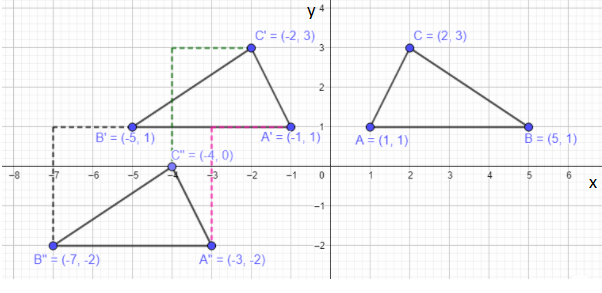
The triangle ΔA′′B′′C′′ can be obtained from ΔABC by two ways of transformation.
1. First flip the triangle ΔABC along y−axis, then move it 2 units left and 3 units down.
2. First move the triangle ΔABC, 3 units down and 2 units right and then flip it over y−axis.

So, we conclude that to obtain ΔA′′B′′C′′from ΔABCa single transformation is not possible.
A single transformation is not possible to obtainΔA′′B′′C′′fromΔABC
Page 466 Exercise 9, Problem1
We have to check, Is there a single transformation using reflections or translations that maps the pre-image onto the image, when you reflect a non-regular figure over the x-axis and then reflect it over the y-axis.
When the figure is reflected over x-axis, its x-coordinate remains the same, and the y-coordinate will get multiplied by−1.
When the figure is reflected over y-axis, its y-coordinate remains the same, and the x-coordinate will get multiplied by−1.
We have to check, Is there a single transformation using reflections or translations that maps the pre-image onto the image, when you reflect a non-regular figure over the x-axis and then reflect it over the y-axis.
This can be understood by example below, Consider triangle ΔABCwith vertices A(2,4), B(5,7), and C(2,8).
First, reflect the triangle over x−axis,
Therefore, the coordinates become,
A(2,4)→A′(2,−4)
B(5,7)→B′(5,−7)
C(2,8)→C′(2,−8)
Now, reflection over y−axis.
Therefore, the coordinates become,
A′(2,−4)→A′′(−2,−4)
B′(5,−7)→B′′(−5,−7)
C′(2,−8)→C′′(−2,−8)
We can see that, there is no any other single transformation such as reflection or translation that can map same ,same image obtained by reflecting original image by X-axis and Y-axis.
No, There is no any other single transformation such as reflection or translation that can map same same image obtained by reflecting original image by X-axis and Y-axis.
Page 466 Exercise 10, Problem1
Given that quadrilateral ABCD is reflected over the x-axis and translated 5 units to the right. When the figure is reflected over x-axis, its x-coordinate remains the same, and the y-coordinate will get multiplied by−1.
We have to find resulting image of point B
Given that quadrilateral ABCD is reflected over the x-axis and translated 5 units to the right.
Coordinates of the point: B(−6,2).
We know that, when the point is reflected over x-axis, then the y-coordinate becomes opposite.
A(x,y)→A′(x,−y)
B(−6,2)→B(−6,−2)
Now translating the point by 5 units to the right, Coordinates of point after translation:
B′(−6,−2)→B′′(−6+5,−2+0)=B′′(−1,−2)
Hence, option (A) (−1,−2)is correct.
The correct option is (A) (−1,−2)
Page 467 Exercise 11, Problem1
Given vertices of square ABCD are A(2,4),B(−2,4),C(−2,8),D(2,8).
When the figure is reflected over x-axis, its x-coordinate remains the same, and the y-coordinate will get multiplied by−1.
Given vertices of square ABCD areA(2,4),B(−2,4),C(−2,8),D(2,8).
When the figure is reflected over x-axis, its x-coordinate remains the same, and the y-coordinate will get multiplied by−1.
Therefore, the coordinates after reflection becomes.
A(2,4)→A′(2,−4)
B(−2,4)→B′(−2,−4)
C(−2,8)→C′(−2,−8)
D(2,8)→D′(2,−8)
Hence, the vertices of reflected square will be,
A′(2,−4),
B′(−2,−4),
C′(−2,−8),
D′(2,−8).
The graphical representation will be,
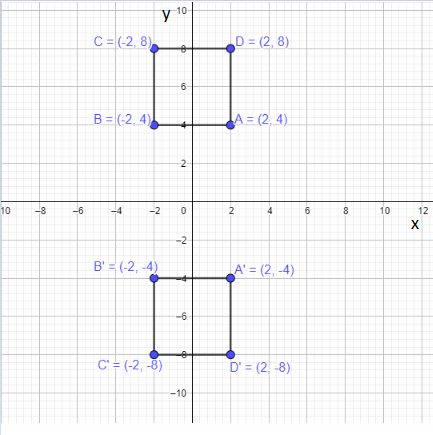
The vertices of reflected square are, A′
(2,−4),B′
(−2,−4),C′
(−2,−8),D′
(2,−8).
Graphical representation is,

Page 467 Exercise 12, Problem1
The coordinates of a point and its image after a reflection are X(−1,−4)→X′(−1,4).
We have to describe the reflection as over the x-axis or y-axis.
When the figure is reflected over x-axis, its x-coordinate remains the same, and the y-coordinate will get multiplied by−1.
When the figure is reflected over y-axis, its y-coordinate remains the same, and the x-coordinate will get multiplied by−1.
The coordinates of a point and its image after a reflection are X(−1,−4)→X′(−1,4).
When the figure is reflected over x-axis, its x-coordinate remains the same, and the y-coordinate will get multiplied by−1.
A(x,y)→A′(x,−y)
When the figure is reflected over y-axis, itsy-coordinate remains the same, and the x-coordinate will get multiplied by−1.
A(x,y)→A′(−x,y)
From the given point, we can see that x-coordinate of the point and its image are the same,and the y-coordinate of the image is opposite to that of its image.
Hence, the point is reflected over x-axis.
The point is reflected over x-axis.
Page 467 Exercise 13, Problem1
Given point and its image is, W(−4,0)→W′(4,0).
We have to describe the reflection as over the x-axis or y-axis. When the figure is reflected over x-axis, its x-coordinate remains the same, and the y-coordinate will get multiplied by−1.
When the figure is reflected over y-axis, its y-coordinate remains the same, and the x-coordinate will get multiplied by−1.
Given point and its image is, W(−4,0)→W′(4,0).
When the figure is reflected over x-axis, its x-coordinate remains the same, and the y-coordinate will get multiplied by−1.
A(x,y)→A′(x,−y)
When the figure is reflected over y-axis, its y-coordinate remains the same,and the x-coordinate will get multiplied by−1.
A(x,y)→A′(−x,y)
From the given point and its image we can see that, y-coordinate of the point and its image are same, and the x-coordinate of the point is opposite to that of image.
Hence, the point is reflected over y-axis.
The point is reflected over y-axis.
Page 468 Exercise 14, Problem1
The given figure is, ΔABC with vertices A(1,-1), B(4,-1), and C(2,-4).
We have to choose the correct alternative as the reflection of the triangle over the x-axis.
Since the reflection is done over the x-axis, we apply the translation notation ⟨x,y)→(x,−y)to the coordinates of the vertices of the triangle.
We match the translated vertices with the vertices of the alternative choices to obtain the correct option.
We are given a triangle, ΔABC with coordinates A(1,-1), B(4,-1), and C(2,-4).
Since we have reflected the figure over the x-axis, the coordinates of the x-axis will be the same and the y-axis coordinates will be opposite signed i.e.
we will multiply -1 with the y-axis coordinates. Hence, the translation notation used is, P⟨x,y)→P′(x,−y).
Therefore, the translated point corresponding to A is, A⟨1,−1)→A′(1,1).
Similarly, the other two translated points are,B⟨4,−1)→B′(4,1) and C⟨2,−4)→C′(2,4).
From the four alternatives, we can see that in the figure at the second option i.e. option (B), the vertices have the coordinates as (1,1), (4,1), and (2,4). So, option (B) is the correct figure.
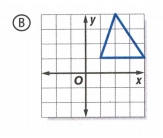
Finally, we can conclude that the figure at option (B) is the correct option for the reflected image of the given figure ΔABC.

Page 468 Exercise 15, Problem1
The given statement is, triangle RST is reflected over the x-axis and then translated 4 units to the right.
We have to determine the coordinates of point R in its new position.
We apply the translation, ⟨x,y)→(x,−y)to the coordinates of vertices of RST for the reflection over the x-axis.
We also add 4 with the x-coordinates of the vertices to signify the shift of 4 units to the right.
We have the figure ΔRST as
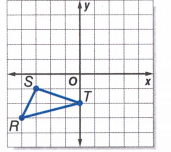
The coordinates of the point R are (-4,-3).
Now, we apply the translation ⟨x,y)→(x,−y)to R for the reflection over the x-axis as,R⟨−4,−3)→R′(−4,3).
Also, the point is shifted units to the right i.e. we have to add 4 with the x-coordinate of R’ as, R′⟨−4,3)→R′′(−4+4,3)→R′′
(0,3).
Therefore, the final position of the point R will be (0,3).
Finally, we can conclude that the coordinates of point R in its new position are R′⟨−4,3)→R′′(0,3).
Page 468 Exercise 16, Problem1
The given statement is, graph and label figure pentagon LMNOP with vertices L(0,3), M(2,2), N(2,0), O(-2,0), and P(-2,2).
We first plot the vertices according to the given coordinates and then link the vertices by straight lines to form the pentagon LMNOP.
We have the vertices of the pentagon LMNOP as L(0,3), M(2,2), N(2,0), O(-2,0), and P(-2,2).
Now, we can plot these points on the graph as

Now, we connect these vertices with straight lines to form the pentagon LMNOP as
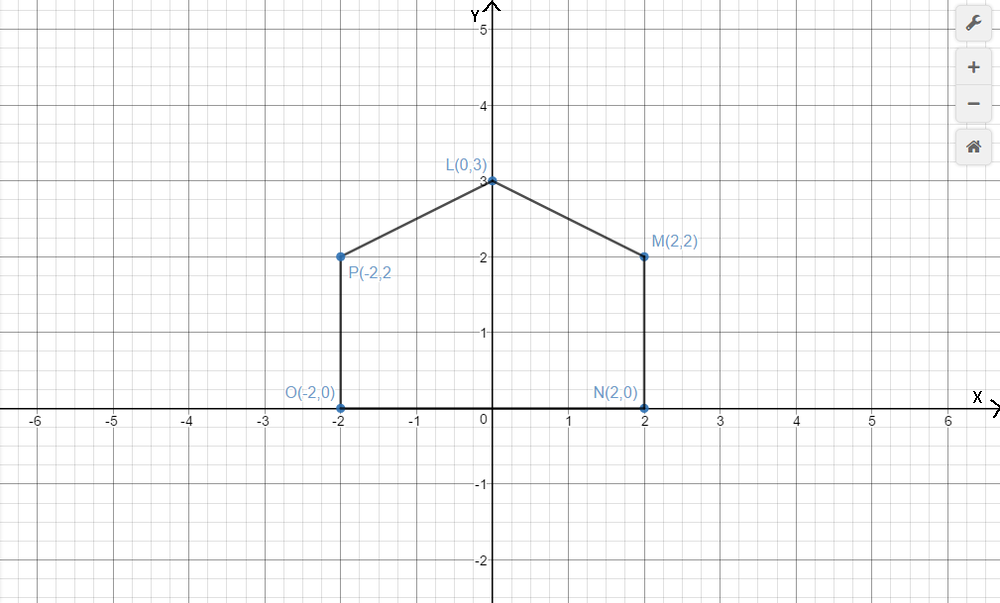
Finally, we can conclude that the pentagon LMNOP can be plotted and labeled as

